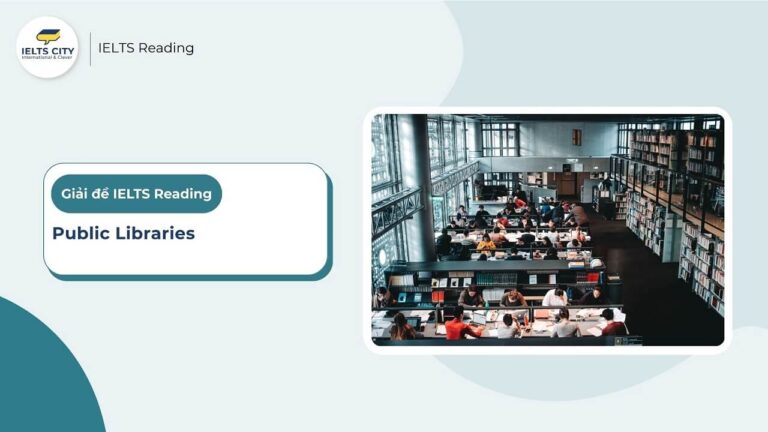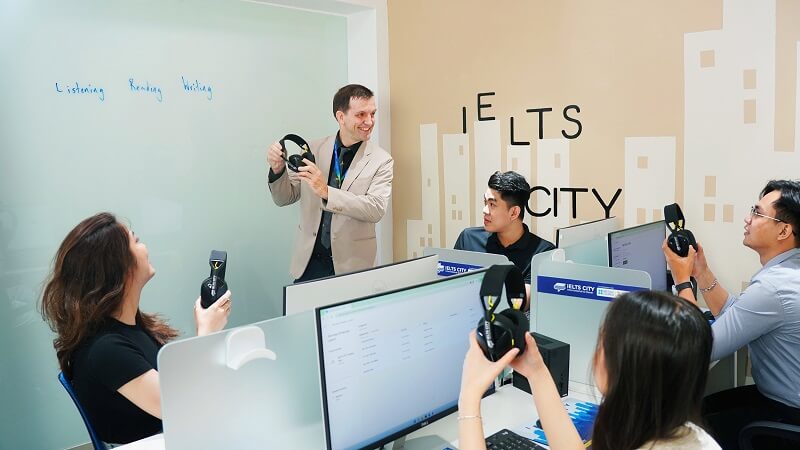Đối với dạng bài Matching Heading trong IELTS Reading bạn cần phải nắm vững các kỹ năng đọc hiểu ý chính của đoạn văn và xác định từ khóa chính xác thì mới nhanh chóng nâng band trong thời gian ngắn. Chính vì thế, IELTS CITY sẽ hướng dẫn bạn đọc cách làm dạng bài Matching Heading trong IELTS Reading giúp bạn tăng tốc độ làm bài và cải thiện khả năng chọn lựa heading một cách chính xác, hiệu quả nhất nhé!

Nội dung chính
Toggle1. Matching Heading là gì?
Matching heading là 1 trong các dạng bài IELTS Reading đòi hỏi cao về khả năng đọc hiểu của thí sinh. Trong dạng bài này, các bạn cần phải tìm tiêu đề phù hợp cho từng đoạn văn theo yêu cầu của đề bài.
Đặc điểm: Đề bài thường sẽ cung cấp nhiều tiêu đề hơn so với số lượng đoạn văn.
(Nguồn đề: Cambridge 18, Test 3, Passage 2: The steam car)
2. Các bước làm bài Matching Heading
Bước 1: Đọc thật kỹ các tiêu đề để hiểu rõ thông tin trong tiêu đề, sau đó xác định và gạch chân các key từ khóa (key words).
Ví dụ: A period in cold conditions before the technology is assessed
Bước 2: Vận dụng các vốn từ có sẵn của bản thân để nghĩ về các từ hoặc cụm từ đồng nghĩa hoặc trái nghĩa, hoặc các cách diễn đạt khác cho tiêu đề.
Ví dụ: A period in cold conditions before the technology is assessed
– period: duration, time, year X to year Y, the X century
– cold: low temperature, frigid, chilly, freezing
– before:prior to,
– technology: scientific advancements, innovations, inventions, machinery
– assessed: evaluated, analyzed, measured.
Bước 3: Đọc đoạn văn đầu tiên được nhắc đến trong câu hỏi. Ở bước này, các bạn nên sử dụng kĩ năng skimming để đọc lướt và tìm ý chính. Thông thường, ý chính sẽ nằm ở các câu như sau:
- Câu đầu tiên hoặc câu thứ hai sẽ thường là câu chủ đề (topic sentence)
- Câu cuối sẽ thường là câu kết của đoạn văn (concluding sentence)
- Những ý được lặp lại nhiều lần
- Một ý riêng biệt được làm rõ bởi các ý còn lại. Các ý còn lại trong đoạn sẽ có nhiệm vụ làm rõ hoặc hỗ trợ ý này, bằng cách đưa ra dẫn chứng, giải thích, kết quả, etc.
A. When primitive automobiles first began to appear in the 1800s, their engines were based on steam power. Steam had already enjoyed a long and successful career in the railways, so it was only natural that the technology evolved into a miniaturized version which was separate from the trains. But these early cars inherited steam’s weaknesses along with its strengths. The boilers had to be lit by hand, and they required about twenty minutes to build up pressure before they could be driven. Furthermore, their water reservoirs only lasted for about thirty miles before needing replenishment. Despite such shortcomings, these newly designed self-propelled carriages offered quick transportation, and by the early 1900s it was not uncommon to see such machines shuttling wealthy citizens around town.
Ví dụ: Trong đoạn này, câu đầu tiên nhắc về việc những chiếc xe đầu tiên được ra mắt công chúng chạy bằng động cơ hơi nước – một phát minh đã có nhiều thành tựu trong ngành giao thông vận tải. (When primitive automobiles first began to appear in the 1800s, their engines were based on steam power.)
Sau đó, những câu tiếp theo hỗ trợ ý này bằng cách nhắc về điểm mạnh và điểm yếu của những chiếc xe này (But these early cars inherited steam’s weaknesses along with its strengths…). Như vậy, đây là trọng tâm cũng như ý chính của đoạn này.
Bước 4: Khi đã tìm được ý chính bằng những cách trên, bạn nên tóm tắt đoạn văn đó lại theo cách mình hiểu trong một cụm từ hoặc một câu ngắn trong đầu. Nếu như là người mới bắt đầu làm quen với dạng đề này, bạn nên dành thời gian viết xuống câu tóm tắt ý chính của đoạn văn để có thể xem lại dễ dàng hơn.
Ví dụ: The pros and cons of steam cars (Thuận lợi và bất lợi của xe có động cơ chạy bằng hơi nước).
Bước 4: So sánh câu tóm tắt của bản thân với các tiêu đề và chọn tiêu đề có ý nghĩa tương tự.
Ví dụ: “The pros and cons of steam cars” sẽ có nghĩa tương tự với tiêu đề iii. Good and bad aspects of steam technology are passed on”
Bước 5: Viết đáp án theo con số La Mã tương đương với tiêu đề phù hợp.
Bước 6: Lặp lại bước 2,3, và 4 cho các đoạn văn còn lại.
3. Các lỗi thường gặp khi làm bài Matching Heading
- Chỉ sử dụng kĩ năng scanning để đọc nhanh và tìm từ khóa như thông thường, dẫn đến việc không phân biệt được ý chính và ý phụ và chọn sai đáp án.
- Chỉ phụ thuộc vào việc đọc câu đầu hoặc câu cuối mà bỏ qua việc đọc hiểu, dẫn đến việc chưa thực sự nắm rõ ý chính của đoạn văn.
- Dành quá nhiều thời gian cho một đoạn văn.
4. Các tips làm bài Matching Heading hiệu quả
- Để làm tốt dạng này, bạn phải phân biệt được ý chính và ý phụ bằng cách xem xét xem đa số các câu trong đoạn văn đó đang hỗ trợ cho ý nào. Không phải lúc nào câu đầu, câu thứ 2, câu cuối hoặc câu cận cuối cũng đều là topic sentence hoặc concluding sentence chứa ý chính. Vì vậy, bạn nên sử dụng cách tìm ý chính ở bước 3 để tránh việc hiểu nhầm ý chính.
- Nếu bạn không tìm được tiêu đề phù hợp trong vòng hai hoặc ba phút, bạn nên đánh dấu đoạn văn đó và tiếp tục đọc và hoàn thành các đoạn văn tiếp theo. Sau đó, bạn có thể sử dụng việc loại trừ để tìm tiêu đề phù hợp.
Cải thiện khả năng skimming bằng cách tạo thói quen đọc sách báo ngắn để tăng tốc độ đọc và khả năng đọc hiểu chung.
5. Bài tập Matching Heading
The steam car
The successes and failures of the Doble brothers and their steam cars
B. But the glory days of steam cars were few. A new technology called the Internal Combustion Engine soon appeared, which offered the ability to drive down the road just moments after starting up. At first, these noisy gasoline cars were unpopular because they were more complicated to operate and they had difficult hand-crank starters, which were known to break arms when the engines backfired. But in 1912 General Motors introduced the electric starter, and over the following few years steam power was gradually phased out.
C. Even as the market was declining, four brothers made one last effort to rekindle the technology. Between 1906 and 1909, while still attending high school, Abner Doble and his three brothers built their first steam car in their parents’ basement. It comprised parts taken from a wrecked early steam car but reconfigured to drive an engine of their own design. Though it did not run well, the Doble brothers went on to build a second and third prototype in the following years. Though the Doble boys’ third prototype, nicknamed the Model B, still lacked the convenience of an internal combustion engine, it drew the attention of automobile trade magazines due to its numerous improvements over previous steam cars. The Model B proved to be superior to gasoline automobiles in many ways. Its high-pressure steam drove the engine pistons in virtual silence, in contrast to clattering gas engines which emitted the aroma of burned hydrocarbons. Perhaps most impressively, the Model B was amazingly swift. It could accelerate from zero to sixty miles per hour in just fifteen seconds, a feat described as ‘remarkable acceleration’ by Automobile magazine in 1914.
D. The following year Abner Doble drove the Model B from Massachusetts to Detroit in order to seek investment in his automobile design, which he used to open the General Engineering Company. He and his brothers immediately began working on the Model C, which was intended to expand upon the innovations of the Model B. The brothers added features such as a key-based ignition in the cabin, eliminating the need for the operator to manually ignite the boiler. With these enhancements, the Dobles” new car company promised a steam vehicle which would provide all of the convenience of a gasoline car, but with much greater speed, much simpler driving controls, and a virtually silent powerplant. By the following April, the General Engineering Company had received 5,390 deposits for Doble Detroits, which were scheduled for delivery in early 1918.
E. Later that year Abner Doble delivered unhappy news to those eagerly awaiting the delivery of their modern new cars. Those buyers who received the handful of completed cars complained that the vehicles were sluggish and erratic, sometimes going in reverse when they should go forward. The new engine design, though innovative, was still plagued with serious glitches.
F. The brothers made one final attempt to produce a viable steam automobile. In early 1924, the Doble brothers shipped a Model E to New York City to be road-tested by the Automobile Club of America. After sitting overnight in freezing temperatures, the car was pushed out into the road and left to sit for over an hour in the frosty morning air. At the turn of the key, the boiler lit and reached its operating pressure inside of forty seconds. As they drove the test vehicle further, they found that its evenly distributed weight lent it surprisingly good handling, even though it was so heavy. As the new Doble steamer was further developed and tested, its maximum speed was pushed to over a hundred miles per hour, and it achieved about fifteen miles per gallon of kerosene with negligible emissions.
G. Sadly, the Dobles’ brilliant steam car never was a financial success. Priced at around $18,000 in 1924, it was popular only among the very wealthy. Plus, it is said that no two Model Es were quite the same, because Abner Doble tinkered endlessly with the design. By the time the company folded in 1931, fewer than fifty of the amazing Model E steam cars had been produced. For his whole career, until his death in 1961, Abner Doble remained adamant that steam-powered automobiles were at least equal to gasoline cars, if not superior. Given the evidence, he may have been right. Many of the Model E Dobles which have survived are still in good working condition, some having been driven over half a million miles with only normal maintenance. Astonishingly, an unmodified Doble Model E runs clean enough to pass the emissions laws in California today, and they are pretty strict. It is true that the technology poses some difficult problems, but you cannot help but wonder how efficient a steam car might be with the benefit of modern materials and computers. Under the current pressure to improve automotive performance and reduce emissions, it is not unthinkable that the steam car may rise again.
Giải thích chi tiết:
| Đoạn B: Steam engines had been replaced by its successor(Sự nổi tiếng của động cơ hơi nước bị lu mờ) => viii. A better option than the steam car arises. | Dẫn chứng: But the glory days of steam cars were few…General Motors introduced the electric starter, and over the following few years steam power was gradually phased out. |
| Đoạn C: The improvements (silent, clean, and swift) to the traditional steam engine made by the Doble gained recognition from the Automobile Magazine. (Các tính năng cải thiện cho động cơ hơi nước cuối cùng đã được công nhận bởi tạp chí Automobile) =>vi. Positive publicity at last for this quiet, clean, fast vehicle | Dẫn chứng: Its high-pressure steam drove the engine pistons in virtual silence, in contrast to clattering gas engines which emitted the aroma of burned hydrocarbons. Perhaps most impressively, the Model B was amazingly swift. |
| Đoạn D: The further improved version had significant customer demand with 5,390 deposits by early 1918. (Bản cải tiến đã có nhu cầu khách hàng đáng kể với 5.390 khoản đặt cọc vào đầu năm 1918) => tiều đề v. Further improvements lead to commercial orders | Dẫn chứng: The brothers added feature…By the following April, the General Engineering Company had received 5,390 deposits for Doble Detroits, which were scheduled for delivery in early 1918. |
| Đoạn E: Abner Doble’s new steam cars faced significant technical issues, causing customer dissatisfaction. (Xe hơi hơi nước mới của Abner Doble gặp phải nhiều vấn đề kỹ thuật nghiêm trọng, gây ra sự không hài lòng từ phía khách hàng.) =>vii. A disappointing outcome for customers | Dẫn chứng: Those buyers…complained that the vehicles were sluggish and erratic. The new engine design, though innovative, was still plagued with serious glitches… |
| Đoạn F: The Doble brothers’ final steam car tested on a freezing morning was a technical success(Chiếc xe hơi hơi nước cuối cùng của anh em nhà Doble được thử nghiệm vào một buổi sáng lạnh giá đã thành công về mặt kĩ thuật.) => i. A period in cold conditions before the technology is assessed | Dẫn chứng: After sitting overnight in freezing temperatures, the car was pushed out into the road and left to sit for over an hour in the frosty morning air… further developed and tested, its maximum speed was pushed to over a hundred miles per hour, and it achieved about fifteen miles per gallon of kerosene with negligible emissions. |
| Đoạn G: The Doble brothers’ steam car wasn’t a financial success, but its durability and clean emissions suggest it could be revived with modern technology. (Chiếc xe hơi hơi nước của anh em nhà Doble không thành công về mặt tài chính, nhưng độ bền và khí thải sạch của nó gợi ý rằng nó có thể được hồi sinh với công nghệ hiện đại.) => iv. A possible solution to the issues of today | Dẫn chứng:It is true that the technology poses some difficult problems, but you cannot help but wonder how efficient a steam car might be with the benefit of modern materials and computers. Under the current pressure to improve automotive performance and reduce emissions, it is not unthinkable that the steam car may rise again. |
Cập nhật xu hướng ra đề Reading mới nhất:
Dạng bài Matching Heading có thể đòi hỏi khả năng phân tích và tổng hợp thông tin nhanh nhạy, nhưng nếu bạn áp dụng đúng kỹ thuật và luyện tập đều đặn, bạn sẽ trở nên tự tin hơn khi đối diện với dạng bài này. Hãy chú ý đến việc đọc lướt để hiểu ý chính của đoạn văn và không sa vào những lựa chọn dễ gây nhầm lẫn. Chúc bạn học tập thật tốt nhé!





















